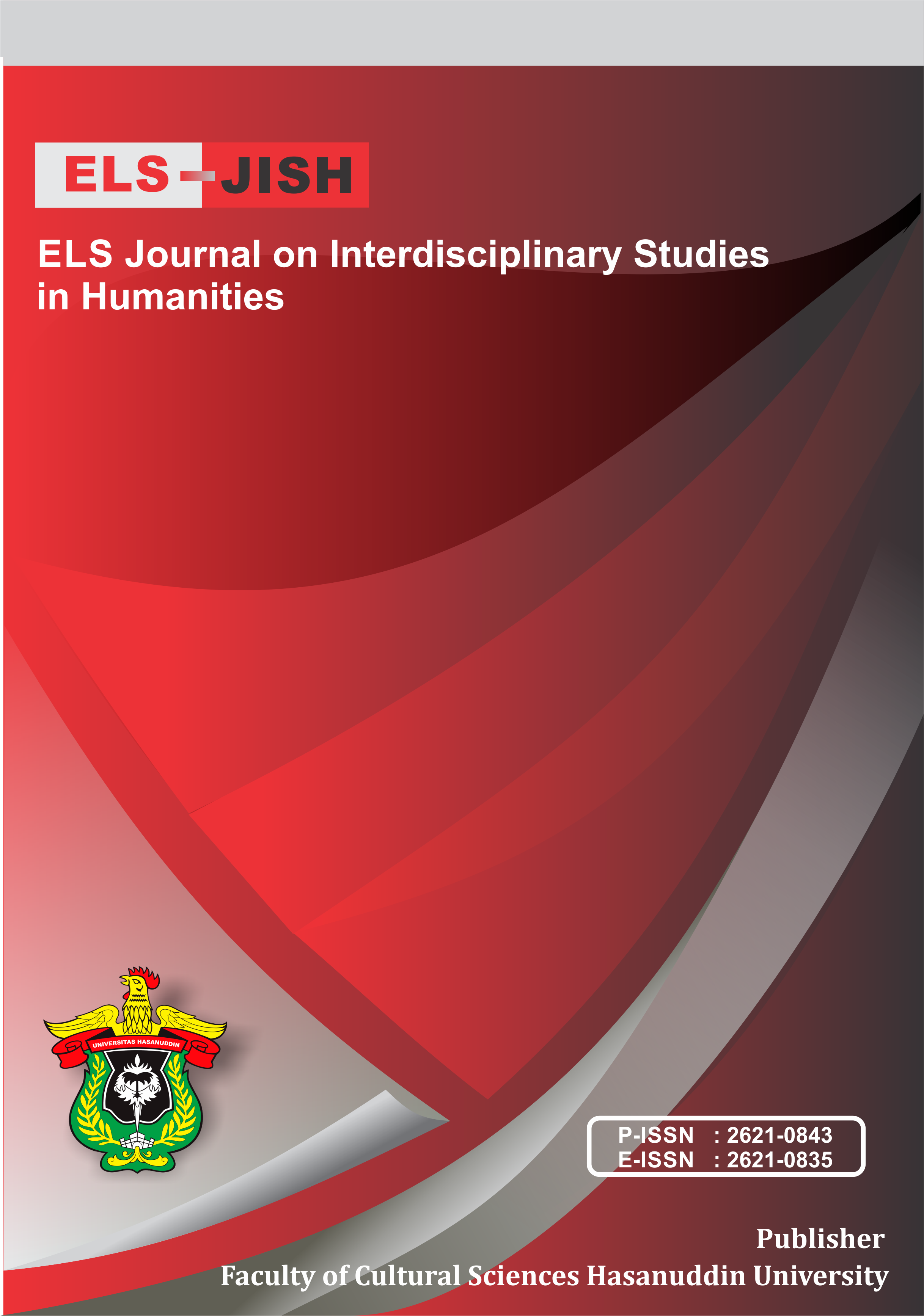Exploring EFL Classroom Interaction: An Analysis of Teacher Talk at Senior High School Level
DOI:
https://doi.org/10.34050/elsjish.v3i3.11061Keywords:
EFL Classroom Interaction, Teacher Talk, FLINT SystemAbstract
The study on teacher talk has been considered as a crucial aspect in EFL classroom interactions due to it assists teachers to build interactive teaching-learning activities. The present study attempts to scrutinize talk types of an in-service teacher in an EFL classroom interaction based on the Foreign Language Interaction (FLINT) system proposed by Moskowitz (1971). It was conducted qualitatively through the lens of a case study by involving an experienced female EFL teacher at a senior high school level. The data were collected through several procedures consist of direct observation, audio recording, and interview section. The result disclosed that from 12 talk types in the FLINT system, 9 types were used by the teacher. One of them ‘praises or encourages’ took place as the highest type. It denoted that the teacher really appreciated the students’ effort to boost their learning motivation. Meanwhile, the least type used by the teacher was ‘criticizes student behavior’. According to the interview result, the teacher rarely used criticism because she tried to keep the students' feelings and mental. Thus, this study is expected to provide a new reference especially for EFL teachers as a consideration in using talk to get students’ attention and participation during the learning process.
References
Afifah, N., Yusnilita, N., & Resiani, V. R. (2017). An Analysis of Teacher Talk in English Classroom Interaction of the Seventh Grade Students of SMPN 23 Oku. ETERNAL (English, Teaching, Learning, and Research Journal), 8(2), 7–28.
Ahangar, S. U., Nadeem, N. A., & Khan, M. A. (2018). Interaction Analysis of Classroom Behaviour of Effective and Ineffective College of Education Teachers. International Journal of Academic Research and Development, 3(2), 1630–1639.
Aisyah, N. (2016). An Analysis of Teachers’ Talk in an EFL Classroom. Journal of English and Education, 4(2), 63–79.
Amatari, V. O. (2015). The Instructional Process: A Review of Flanders’ Interaction Analysis in a Classroom Setting. International Journal of Secondary Education, 3(5), 43–49.
Arif, Q; Zaim, M; & Refnaldi. (2019). Analyzing Teacher Talk in Classroom Interaction at Junior High School. Advances in Social Science, Education and Humanities Research, 301, 311–318.
Ary, D., Jacobs, L., & Sorensen, C. (2010). Introduction to Research in Education (8th ed.). Wadsword: Cengage Learning.
Chambliss, D. F., & Schutt, R. K. (2013). Making Sense of the Social World, Methods of Investigation (4th ed.). Thousand Oaks, CA: SAGE Publication.
Diaz-Ducca, J. A. (2014). Positive Oral Encouragement in the EFL Classroom: A Case Study. Revista de Lenguas ModeRnas, 21, 325-346.
Eisenring, A. A., & Margana. (2018). An Analysis of Teacher Talk in a Senior High School in Palu, Central Sulawesi through the Use of Self-Evaluation of Teacher Talk ( SETT). Jurnal Pendidikan Humaniora, 6(4), 188–200.
Ferguson, M. (2013). Praise: What Does the Literature Say? What Are the Implications for Teachers? Kairaranga, 14(2), 35-39.
Flanders, N. A. (1970). Analyzing Teacher Behavior. New York: Addison-Wesley Publishing Co.
Giorgdze, M., & Dgebuadze, M. (2017). Interactive Teaching Methods: Challenges and Perspectives. IJAEDU-International E-Journal of Advances in Education, 3(9), 544–548. https://doi.org/10.18768/ijaedu.370419.
Maulana, R., Opdenakker, M. C., Stroet, K., & Bosker, R. (2012). Observed Lesson Structure During the First Year of Secondary Education: Exploration of Change and Link with Academic Engagement. Teaching and Teacher Education, 28(6), 835-850.
Miles, M.B., Huberman, A.M. & Saldana, J. (2014). Qualitative Data Analysis: A Methods Sourcebook (3rd Edition). London: Sage.
Moskowitz, G. (1971). Interaction Analysis—A New Modern Language for Supervisors. Foreign Language Annals, 5(2), 211-221. DOI: 10.1111/j.1944-9720.1971.tb00682.x
Mu'in, F., Arini, D., & Amrina, R. (2018). Language in Oral Production Perspectives. Bandung: CV Rasi Terbit.
Nasir, C., Yusuf, Y. Q., & Wardana, A. (2019). A Qualitative Study of Teacher Talk in an EFL Classroom Interaction in Aceh Tengah, Indonesia. Indonesian Journal of Applied Linguistics, 8(3), 525–535. DOI: 10.17509/ijal.v8i3.15251
Nisa, Sinta. H. (2014). Classroom Interaction Analysis in Indonesian EFL Speaking Class. Journal of English Education, 2(2), 124–132.
Rosenshine, B. (2012). Principles of Instruction: Research-Based Strategies That All Teachers Should Know. American Educator, 36(1), 12–39. https://doi.org/10.1111/j.1467-8535.2005.00507.x
Rustandi, A., & Mubarok, A. H. (2017). Analysis of IRF (Initiation-Response-Feedback) on Classroom Interaction in EFL Speaking Class. EduLite: Journal of English Education, Literature and Culture, 2(1), 239–250.
Sinclair, J. M., & Brazil, D. (1982). Teacher Talk. London: Oxford University Press.
Sofyan, R; & Mahmud, M. (2014). Teacher Talk in Classroom Interaction: A Study at an English Department in Indonesia. Journal of English Language Teaching, 1(1), 59–70.
Sundari, H., Rafli, Z., & Ridwan, S. (2017). Interaction Patterns in English as Foreign Language Classroom at Lower Secondary Schools. English Review: Journal of English Education, 6(1), 99-108.
Suryati, N. (2015). Classroom Interaction Strategies Employed by English Teachers at Lower Secondary Schools. TEFLIN Journal, 26(2), 247–264. http://dx.doi.org/10.15639/teflinjournal.v26i2/247-264
Walsh, S. (2011). Exploring Classroom Discourse: Language in Action. New York: Taylor and Francis Ltd 5. https://doi.org/10.4324/9780203827826.
Wang, H. (2014). The Analysis of Teacher Talk in "Learner-Centered" Teaching Mode. International Journal of Social, Behavioral, Educational, Economic, Business and Industrial Engineering, 8(4), 1172–1174.
Wasi’ah, N. (2016). A Study of Teacher Talk in Classroom Interaction at an Islamic Senior High School. OKARA: Jurnal Bahasa dan Sastra, 1(1), 29–43.
Wright, B. (2016). Display and Referential Questions: Effects on Student Responses. Nordic Journal of English Studies, 15(4), 160-189.
Yanfen, L., & Yuqin, Z. (2010). A Study of Teacher Talk in Interactions in English Classes. Chinese Journal of Applied Linguistics, 33(2), 76-86.
Yanita, F., Yusuf, Y. Q., & Gani, S. A. (2016). “Oke, Any Questions?” The Questioning Interaction in an EFL Classroom. Proceedings of The 6th Annual International Conference Syiah Kuala University (AIC Unsyiah) in conjunction with The 12th International Conference on Mathematics, Statistic and Its Application (ICMSA) (pp. 328-333). October 4-6, Banda Aceh, Indonesia.
Yin, R. K. (2018). Case study research and applications: Design and methods (6th ed). Thousand Oaks, CA: Sage.
Downloads
Published
How to Cite
Issue
Section
License
Copyright (c) 2020 ELS Journal on Interdisciplinary Studies in Humanities

This work is licensed under a Creative Commons Attribution-NonCommercial 4.0 International License.






